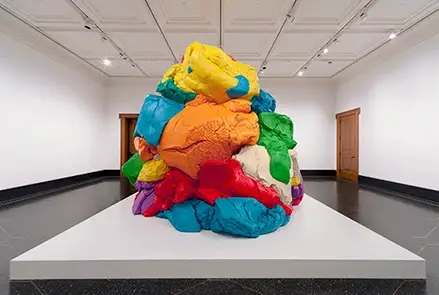Title of Artwork: “Play-Doh”

Artwork by Jeff Koons
Year Created 1994-2014
Summary of Play-Doh
Play-Doh seems to be made from gigantic, randomly scattered shards of the renowned modelling material in Koons’ Celebration series, one of the biggest and most complicated sculptures. However, it is really made up of twenty-seven metal parts that are interlocked together. Although just portions of each work are visible to viewers, Koons’ quest for perfection requires that each be painted in its entirety despite the fact that the pieces are kept together only by gravity. The sight of Play-Doh brings back memories for generations of people, evoking the aroma and tactile attraction of it. This piece by one of the world’s most renowned sculptors, returning to square one, has a hilarious, self-referential quality to it. Here, Play-Doh is elevated to an art form. Seeing the mound as a visceral memento to childhood, it dwarfs the visitor. Especially poignant considering Koons’s claim that the piece was inspired by his son’s gift of Play-Doh to him when he was a toddler “He was beaming with pride. When I saw it, I realised that this is exactly what I want to create as an artist on a daily basis: items that defy categorization. Just knowing that everything is beautiful makes it easier to accept.”
All About Play-Doh
More Love Hours Than Can Ever Be Paid, The Wages of Sin and Deodorized Central Mass with Satellites are all examples of Mike Kelley works that include vast assemblages based on childhood toys, such as Play-Doh (1991-99). In the second, Kelley mocks Abstract Expressionism with amorphous spheres of plush toys. Although the sculpture looks to be spontaneous, it was meticulously created and built by Koons to provide the impression of spontaneity. The contemporary artist, who is more of a designer than a maker, is shown to create conflicts in this work. The sculpture looks to have been formed by human hands, exhibiting the impressions of large fingers, but was really constructed by staff without the physical participation of the artist.
For Koons the passing of time is highlighted in his Celebration series which features parties, holiday celebrations, and other yearly markers. Koons draws attention to the cycle of birth, development, and sexual reproduction in many of his works by using the symbols of childhood to allude to these occasions. In Play-Doh, the artist alludes to this process by claiming that, “While it’s not visible to the general public, it’s there if you peel the Play-Doh apart. It has a little Freudian element to it because of the way the organic forms stack on top of one another. Play-Doh, in my opinion, perfectly portrays the twentieth century, with its mounds of organic forms stacked on top of one other.”
Play-Doh was the culmination of two decades of preparation and execution when it was first shown at the Whitney Museum of American Art’s 2014 Retrospective Exhibition. New York Times writer Roberta Smith described the expansion of the rainbow pile of brilliant bits as “an almost certain masterpiece” that catches precisely the matte textures of the actual thing, but also recalls “paint, dessert, and psychedelic poop” in her review.
Information Citations
En.wikipedia.org, https://en.wikipedia.org/.

























